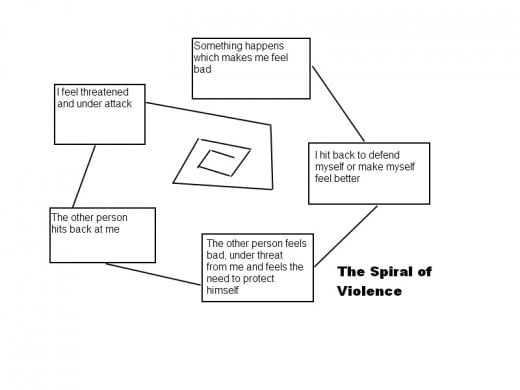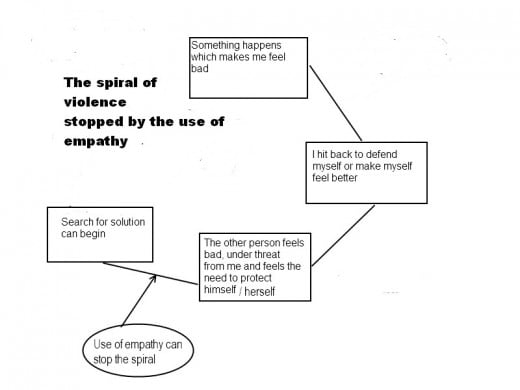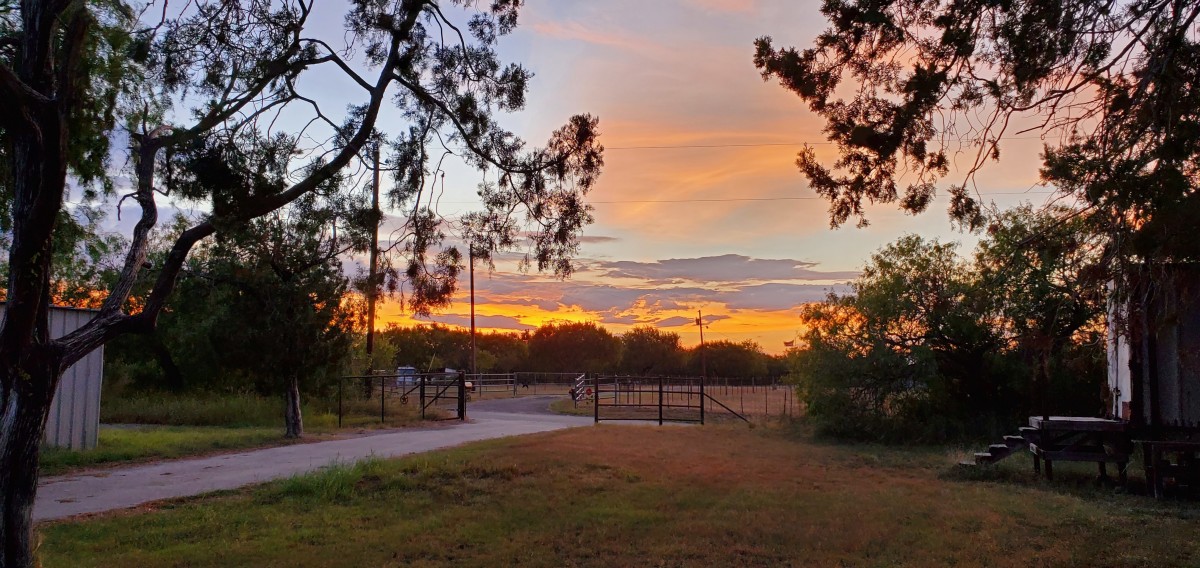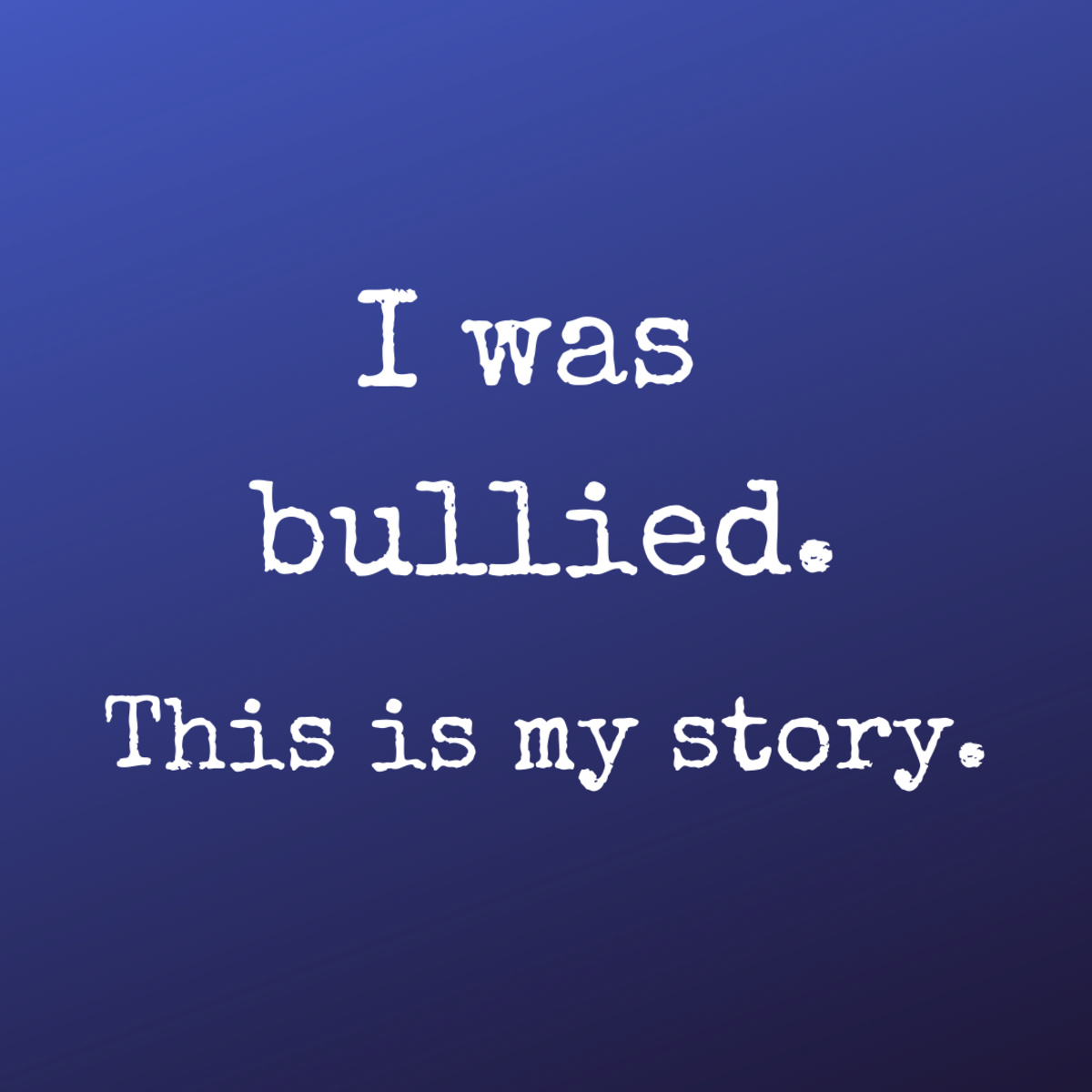How to deal with hatred, prejudice and violence
Defence mechanism
The Penguin Dictionary of Psychology defines hate as a “deep, enduring, intense emotion expressing animosity, anger, and hostility towards a person, group, or object.” Because it is “enduring” it can be seen more as an attitude than a short-lived emotional state.
In the psycho-dynamic view we tend to project onto others what we cannot face in ourselves, what we reject in ourselves. We tend to split off from ourselves the bits of our personality or psychological structure that we do not want to acknowledge. This leads to blaming and scapegoating – “it's not me, it's them.”
In this way we are able to protect our self-images and avoid knowing ourselves and at the same time we can denounce another person or group for being what we cannot face in ourselves. This is called a defence mechanism.

A Poison Tree by William Blake
I was angry with my friend:
I told my wrath, my wrath did end.
I was angry with my foe:
I told it not, my wrath did grow.
And I watered it in fears,
Night and morning with my tears;
And I sunned it with smiles,
And with soft deceitful wiles.
And it grew both day and night,
Till it bore an apple bright.
And my foe beheld it shine.
And he knew that it was mine,
And into my garden stole
When the night had veiled the pole;
In the morning glad I see
My foe outstretched beneath the tree.

The denial of death
In close inter-personal relationships I can, for example, project my feeling of anger onto my father and say, “He hates me. He doesn't even try to understand me.” In this way I avoid having to look into myself and confront my own feelings of anger. Then my wife might innocently ask me why I am so late home from work and I lash out at her, without understanding why.
We are all mortal. This is a truism, so obvious, and yet it something that every human being struggles with. It is very difficult to face the certainty of death. We deny it, we fight against it, we believe at some level that it won't happen to us. And yet it will, absolutely and inevitably.
In our attempts to avoid accepting the inevitability of our death we tend to look for certainty in other things, most often the cultural group to which we belong.
This group gives us security and comfort and we identify strongly with it. But there are still within us things that we would prefer not to acknowledge as being part of ourselves, maybe sexual urges, maybe murderous urges, or anything else that makes us feel bad. It is quite easy to project these things onto people who are not part of our group - “they” are murderous, “they” want to rape our women, and so on. And so prejudice is born.
Prejudice at an intellectual level is quite easy to deal with. If I believe that, for example, Indians cheat, and I then meet an Indian who is transparently honest, I can no longer maintain my belief that Indians cheat.
The problem is that prejudice is not just an intellectual thing, it is deep seated and rooted in enduring emotions, so that even when I meet that transparently honest Indian, I will modify my prejudice just enough to accommodate this individual Indian, but I will still hold onto my belief that Indians cheat. Because letting go of that belief somehow threatens my self-image, my self-esteem, and I will not allow that to happen.
I will continue to project the cheating part of me onto the generic “Indians” so that I don't have to face the fact that I want to, or in fact do, cheat in monetary matters. This is a deeply satisfying thing to us because it allows us, when we meet an Indian who does cheat, to say with a kind of gloating triumph, “See, I told you Indians cheat.” This is great for our self-esteem – we are affirmed – and also further entrenches the prejudice.
When prejudice becomes hatred it usually results in action. The hatred fuels action against the object of our prejudice. This is the start of the spiral of violence, which can so easily spin out of control and pull into its vortex people who were not part of the original situation.


An act of imagination
This can happen in a family, in a clan, in a country. A group of people is dispossessed of their land and their family structures are shaken. In this situation it is so easy to look for a scapegoat to blame. The fact of the matter might be that another group has done this, but instead of negotiating or reasoning with that group the dispossessed project their hatred and incomprehension onto the other group – it's because they don't care, they are unfeeling, they have no respect for our traditions.
Then the dispossessed group might find some way to get back at the group which dispossessed them. Now the roles are reversed. The group being attacked will now have the opportunity to project their feelings onto the group attacking them – see, we told you they were violent and didn't deserve that land in the first place! And so it will go on until someone takes the risk, dares, to do something to stop the spiral.
The risk that is needed to stop the spiral of violence, and it is a big risk, is to use the imagination, to use the quality and attitude of empathy.
Heinz Kohut defined empathy as “the capacity to think and feel oneself into the inner life of another person.” It is to stand in the other person's shoes. And empathy is an act of the imagination.
In her June 2008 Harvard Commencement address Harry Potter author J.K. Rowling said: “Imagination [...] is the power that enables us to empathize with humans whose experiences we have never shared. Unlike any other creature on this planet, humans can learn and understand, without having experienced. They can think themselves into other people's minds, imagine themselves into other people's places. Many prefer not to exercise their imaginations at all. They can close their minds and hearts to any suffering that does not touch them personally. [...] Those who choose not to empathize may enable real monsters. For without ever committing an act of outright evil ourselves, we collude with it, through our own apathy.”

The Empathy Poster
The first step
To true peace and harmony
In our families
In our schools
In our places of work
In our neighborhoods and our communities
In our countries
In our world.
Reach out to people of another race, another nationality,
Another gender, another age, another religion,
To “an other” of any kind,
and
Open up to their experiences,
Their feelings,
Their uniqueness
And their universal humanness.
Because you can’t hate,
And you won’t want to hurt,
Someone you know as a human being,
Someone you understand and respect.
With Empathy comes appreciation, acceptance, love and peace.
- from "The Empathy Poster"
The risk in empathy
Empathy effectively stops projections and prejudice. I cannot continue to project my unacknowledged and unacceptable feelings, the split-off parts of me, onto the other person when I try to see the world from where they are standing.
A huge risk in this, of course, is that I might change. I might have to revise some of my prejudices against a particular person or race as soon as I start to understand the world as that person or race sees it. I might have to let go of some of my defence mechanisms, like projection, if I use my imagination to get into the other person's reality. Dropping defence mechanisms can be very scary.
That is why it is so much easier to carry on holding onto my defences, believing things in spite of strong evidence against my beliefs. It is not rational, but it is more comfortable, easier, than the alternative.
The alternative, though, is really what makes us human. As Rowling said, it is the quality which humans have that no other creature has. It is the power of our potential.
Looking at the world around us we can see the effects of a dualistic, us and them, point of view is leading us down a slippery slope.
To stop the slide, to break the spiral of violence, we need to help each other use our imaginations to start the process of seeing life form the “other's” point of view. We need to help each other because we cannot do it alone. The system of projection and counter-projection is too big, it is too powerful, for anyone to do it alone.
How we can hep each other is by making the effort, every day, to understand a little more, how other people feel. We can help each other by sharing information and experiences. We can help each other by showing respect to each other. We can help each other by refusing to sign on to the hate campaigns, by refusing to be complicit in the spreading of disinformation about other people. We can help each other by refusing to put labels onto other people and then relating only to the labels and not to the people.
It won't be easy, but if we don't start with ourselves, it won't ever start.
The alternative is to stare down the barrel of a very large weapon and hope like hell that it won't go off and take us all with it. And that is a very slender hope.
One resource I recommend on the Internet is the “Empathy Symbol”, a symbol which is an attempt to show the inter-connectedness of all that we can start to understand through empathy. The link to the site is below.
Copyright Notice
The text and all images on this page, unless otherwise indicated, are by Tony McGregor who hereby asserts his copyright on the material. Should you wish to use any of the text or images feel free to do so with proper attribution and, if possible, a link back to this page. Thank you.
© Tony McGregor 2010
Useful links
- Is White Pride Racist
Proud to be White Mark Monroe February 2, 2010 Is it possible to be White[1], to be proud of being White and not be a racist? The reason this article is raising this particular question... - The Empathy Symbol: a symbol for today
The Empathy Symbol stands for reaching out to the other and then opening up to truly understand each other. Use the empathy symbol to indicate your support for a world in which we all can get along. - The anger management poem
The rage and despair flow inside Claiming the extra vigorous hate that I hide It was been crawling for quite a long while The pain, revulsion, and resentment by time pile > Stop! Breathe in...








